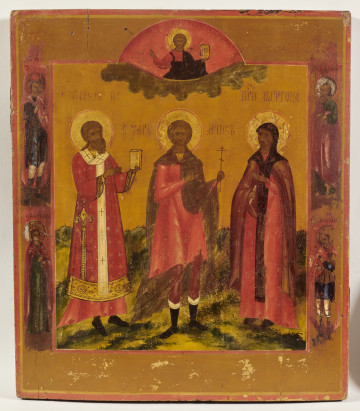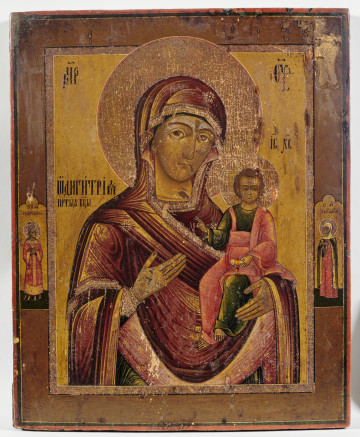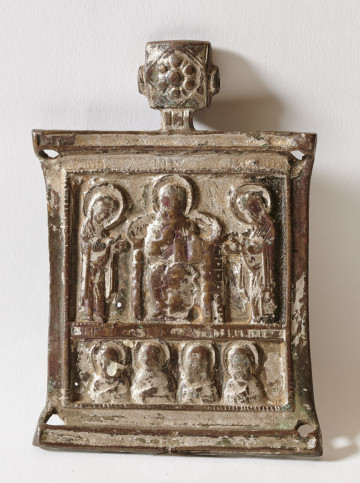
Council of Saints
koniec XIX w.
Castle Museum in Łańcut
Part of the collection: Varia
Amor’s Chariot was made using the micromosaic (mosaici in piccolo, mosaico minuto) technique. It was a method of “painting” based on the arrangement of small hard elements in various colours according to the planned composition. Their proper selection and assembly made it possible to reproduce the intended topic in a suggestive spatial manner. As the name suggests, micromosaics differed from the original technique – mosaic – in respect of a reduced scale of elements from which the picture, usually also of a small format, was built. The building material consisted of small, usually four-sided pieces of non-transparent glass (smalti filati) with a plastic structure arranged on a consolidating mass – putty. This technique was elaborated in the last quarter of the 18th century in Rome. At the end of the 18th century and in the first half of the 19th century, paintings made in this manner became one of the most popular objects purchased by Europeans from outside the Alps making their Italian Grand Tour.
The item shown here in the micromosaic technique shows a chariot surrounded with attributes that we can identify with an allegorical representation of love. The chariot is led by two kissing doves tied with a ribbon – one of them stands on a column, and the other stands on the ground. In the empty chariot, we can see a quiver of arrows – the weapon of Amor, the god of love. The burning torch can also be interpreted as a visual reflection of the passionate feeling, and the butterfly flying above it is a symbolic representation of Amor’s lover Psyche. The story of this couple’s love was written by Lucius Apuleius Madaurensis (2nd century AD) and has become one of the more popular mythological narrations in art. The story of Amor symbolising carnal love and Psyche, whose figure symbolises soul, is a reflection of the dichotomous nature of love: its carnal and spiritual aspect. It is worth mentioning that the story of this couple was also told in frescoes adorning the galleries of the Wilanów Palace. The author of the presented mosaic is unknown. It is highly probable that the mosaic was created in Rome at the turn of the 19th century.
Dimensions
entire object: height: 31,3 cm, width: 35,9 cm
Object type
painting
Technique
mosaic,gilding
Material
glass,stone
Owner
Museum of King Jan III's Palace at Wilanów
Identification number
Location / status

koniec XIX w.
Castle Museum in Łańcut

połowa XIX wieku
Castle Museum in Łańcut

XIX century
Castle Museum in Łańcut
DISCOVER this TOPIC
National Museum in Szczecin
DISCOVER this PATH
Educational path